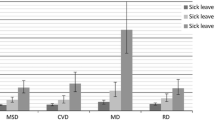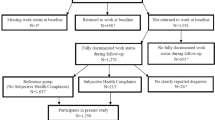Abstract
Objectives: Our aims were to study to what extent chronically ill workers (CIWs) take more sick leave than non-chronically ill workers (NCIWs) and to explore which health-related and work-related aspects are associated with the sick leave patterns of the two groups. Methods: A questionnaire on work, health and sick leave was sent to all employees of a university in The Netherlands (response: 49.1%). Analyses were conducted for 444 CIWs and 1,347 NCIWs. Odds ratios (ORs) were calculated to quantify the contribution of being chronically ill to sick leave in general, frequent sick leave, prolonged sick leave, and present sick leave. The contributions of health-related and work-related aspects to sick leave were investigated by multiple logistic regression analyses for both CIWs and NCIWs separately. Results: CIWs showed significantly increased ORs for general, frequent, prolonged and present sick leave when compared with NCIWs. Fatigue, emotional exhaustion and perceived health complaints showed stronger associations with sick leave for both CIWs and NCIWs than various work-related aspects. Workers of 46 years of age and older showed less sick leave than workers under the age of 36. Male respondents and scientific personnel showed less frequent sick leave than the other respondents, and so did respondents working more than 40 h a week, compared with part-timers. The final regression models explained 8%–16% of the variance in sick leave. Conclusions: CIWs take two to three times more and longer sick leave than NCIWs. Health-related aspects are more strongly associated with sick leave than work-related aspects for both CIWs and NCIWs. Sick leave patterns were, nevertheless, only partly explained by health-related and work-related aspects. In any case, future studies of sick leave should certainly take the presence of chronic disease into account as an important determinant of sick leave.
Similar content being viewed by others
References
Alberts M, Smets EMA, Vercoulen JHMM, Garssen B, Bleijenberg G (1997) “Verkorte vermoeidheidsvragenlijst”: een praktisch hulpmiddel bij het scoren van vermoeidheid [“Abbreviated fatigue questionnaire”: a practical tool in the classification of fatigue]. Ned Tijdschr Geneeskd 141:1526–1530
Alexopoulos EC, Burdorf A (2001) Prognostic factors for respiratory sickness absence and return to work among blue collar workers and office personnel. Occup Environ Med 58:246–252
Baanders AN, Rijken PM, Peters L (2002) Labour participation of the chronically ill. A profile sketch. Eur J Public Health 12:124–130
Bensing JM, van Lindert H (2003) Vermoeider dan ooit [More tired than ever]. Med Contact 58:551–555
Bergers GPA, Marcelissen FHG, de Wolf Ch (1986) Vragenlijst Organisatie Stress-D [Organizational Stress Questionnaire. Department of Work and Organizational Psychology, University of Nijmegen, Nijmegen
Boot CRL (2004) Sick leave in asthma and COPD: the role of the disease, adaptation, work, psychosocial factors and knowledge. Radboud Universiteit Nijmegen, Nijmegen
Burdorf A, Post W, Bruggeling T (1996) Reliability of a questionnaire on sickness absence with specific attention to absence due to back pain and respiratory complaints. Occup Environ Med 53:58–62
CBS (2001) Bijna anderhalf miljoen mensen met een arbeidshandicap [Nearly one and a half million disabled workers]. http://www.cbs.nl/nl/publicaties/persberichten/2001/pb01n280 pdf
CBS (2003a) Profiel arbeidsgehandicapten [Profile of disabled workers]. http://statline.cbs.nl
CBS (2003b) Vademecum gezondheidsstatistiek Nederland 2003 [Vademecum health statistics for the Nederlands 2003]. Voorburg/Heerlen
CBS (2003c) Vrouwen hebben meer gezondheidsklachten ondanks gezondere leefstijl [Women have more health complaints despite a healthier life style]. http://www.cbs.nl/nl/publicaties/persberichten/2003/pb03n106 pdf
De Jonge J, Landeweerd JA, Nijhuis FJN (1995) Constructie en validering van de vragenlijst ten behoeve van het project “autonomie in het werk” [Construction and validation of the questionnaire used in the project “autonomy in work”]. Rijksuniversiteit Limburg, Maastricht
De Jonge J, Bosma H, Peter R, Siegrist J (2000) Job strain, effort-reward imbalance and employee well-being: a large-scale cross-sectional study. Soc Sci Med 50:1317–1327
Detaille SI, Haafkens JA, van Dijk FJH (2003) What employees with rheumatoid arthritis, diabetes mellitus and hearing loss need to cope at work. Scand J Work Environ Health 29:134–142
Dirken JM (1969) Arbeid en stress [Work and stress]. Wolters Noordhoff, Groningen
Donders NCGM, van der Gulden JWJ, Furer JW, Tax B, Roscam Abbing EW (2003) Work stress and health effects among university personnel. Int Arch Occup Environ Health 76:605–613
Donders NCGM, Roskes K, van der Gulden JWJ (2005) Vermoeidheid, emotionele uitputting en ervaren gezondheidsklachten in relatie tot werkaspecten bij werknemers met en zonder chronische ziekte [Fatigue, emotional exhaustion and perceived health complaints in relation to work-related aspects among workers with and without a chronic disease]. Tijdschr Gezondheidswet 83:25–34
Geurts S, Rutte C, Peeters M (1999) Antecedents and consequences of work–home interference among medical residents. Soc Sci Med 48:1135–1148
Gjesdal S, Bratberg E (2002) The role of gender in long-term sickness absence and transition to permanent disability benefits. Results from a multiregister based, prospective study in Norway 1990–1995. Eur J Public Health 12:180–186
Gründemann RWM, Nijboer ID (1998) Factoren die reïntegratie bevorderen en belemmeren [Factors promoting and blocking rehabilitation]. In: Hoogduin WA, Hoogduin CAL, Vossen CJC (eds) Richtlijnen bij werkhervatting na psychische problemen. Bohn Stafleu Van Loghem, Houten/Diegem
Harvey J, Nicholson N (1999) Minor illness as a legitimate reason for absence. J Organ Behav 20:979–993
Heliövaara M, Aromaa A, Klaukka T, Knekt P, Joukamaa M, Impivaara O (1993) Reliability and validity of interview data on chronic diseases. The Mini-Finland Health Survey. J Clin Epidemiol 46:181–191
Hensing G, Spak F (1998) Psychiatric disorders as a factor in sick-leave due to other diagnoses. A general population-based study. Br J Psychiatry 172:250–256
Jenkins R (1985) Minor psychiatric morbidity in employed young men and women and its contribution to sickness absence. Br J Ind Med 42:147–154
Kessler RC, Greenberg PE, Mickelson KD, Meneades LM, Wang PS (2001) The effects of chronic medical conditions on work loss and work cutback. J Occup Environ Med 43:218–225
Kleinbaum DG, Kupper LL, Morgenstern H (1982) Information bias. In: Kleinbaum DG, Kupper LL, Morgenstern H (eds) Epidemiologic research. Van Norstrand Reinhold, New York
Kriegsman DMW, Penninx BWJH, van Eijk JTM, Boeke AJP, Deeg DJH (1996) Self-reports and general practitioner information on the presence of chronic diseases in community dwelling elderly. A study on the accuracy of patients’ self-reports and on determinants of inaccuracy. J Clin Epidemiol 49:1407–1417
Kristensen TS (1995) The demand–control–support model: methodological challenges for future research. Stress Med 11:17–26
Mayfield JA, Deb P, Whitecotton L (1999) Work disability and diabetes. Diabetes Care 22:1105–1109
McDonough P, Walters V (2001) Gender and health: reassessing patterns and explanations. Soc Sci Med 52:547–559
Molarius A, Janson S (2002) Self-rated health, chronic diseases, and symptoms among middle-aged and elderly men and women. J Clin Epidemiol 55:364–370
Nagelkerke NJD (1991) A note on a general definition of the coefficient of determination. Biometrika 78:691–692
Nunnally JC (1978) Psychometric theory. McGraw-Hill, New York
Poole CJ, Gibbons D, Calvert IA (1994) Sickness absence in diabetic employees at a large engineering factory. Occup Environ Med 51:299–301
Skerjanc A (2001) Sickness absence in diabetic employees. Occup Environ Med 58:432–436
Smulders PGW, op de Weegh JMJ (1995) Arbeid en gezondheid: risicofactoren. [Work and health: risk factors]. Uitgeverij LEMMA BV, Utrecht
Vahtera J, Kivimaki M, Pentti J (1997) Effect of organisational downsizing on health of employees. Lancet 350:1124–1128
Van de Mheen H, Stronks K, Schrijvers CTM, Mackenbach JP (1999) The influence of adult ill health on occupational class mobility and mobility out of and into employment in The Netherlands. Soc Sci Med 49:509–518
Van den Bosch GAM, Danner SA, de Haan RJ, Schadé E (2000) Chronisch zieken en gezondheidszorg [Chronically ill and health care]. Elsevier Gezondheidszorg, Maarssen
Van Deursen CGL, Smulders PGW, Bongers PM (1997) Vormt een slechte gezondheid een ziekteverzuimrisico? [Is ill health a risk for sick leave?]. T Soc Gezondheidsz 75:157–164
Van Deursen CGL, Houtman ILD, Bongers PM (1999) Werk, privé-situatie, riskante gewoonten en ziekteverzuim: verschillen tussen mannen en vrouwen [Work, private situation, behavioural risks and sick leave: differences between men and women]. Tijdschr Gezondheidswet 77:105–115
Van Poppel MNM, de Vet HCW, Koes BW, Smid T, Bouter LM (2002) Measuring sick leave: a comparison of self-reported data on sick leave and data from company records. Occup Med (Lond) 52:485–490
Van Veldhoven M, Meijman TF (1994) Het meten van psychosociale arbeidsbelasting met een vragenlijst. De Vragenlijst Beleving en Beoordeling van de Arbeid (VBBA) [The measurement of psychosocial workload and work stress with a questionnaire. Questionnaire on experience and evaluation of work]. Nederlands Instituut voor Arbeidsomstandigheden, Amsterdam
Van Veldhoven M, Broersen JPJ (1999) Psychosociale arbeidsbelasting en werkstress in Nederland. Een verkenning gebaseerd op gegevens verzameld door arbodiensten met de Vragenlijst Beleving en Beoordeling van de Arbeid (VBBA) in de periode 1995 t/m 1998. [Psychosocial workload and workstress in The Netherlands. An exploration based on data collected through occupational health services with the questionnaire on the experience and evaluation of work in the period 1995 through 1998]. Stichting Kwaliteitsbevordering Bedrijfsgezondheidszorg (SKB), Amsterdam
Waclawski ER (1990) Sickness absence among insulin-treated diabetic employees. Diabet Med 7:41–44
Acknowledgments
We would like to thank Cécile Boot, Joop Furer, Bert Tax and Ernst Roscam Abbing for their valuable advice and comments on earlier drafts of this article. Hans Bor is greatly acknowledged for his statistical assistance.
Author information
Authors and Affiliations
Corresponding author
Rights and permissions
About this article
Cite this article
Roskes, K., Donders, N. & van der Gulden, J. Health-related and work-related aspects associated with sick leave: a comparison of chronically ill and non-chronically ill workers. Int Arch Occup Environ Health 78, 270–278 (2005). https://doi.org/10.1007/s00420-004-0596-0
Received:
Accepted:
Published:
Issue Date:
DOI: https://doi.org/10.1007/s00420-004-0596-0




